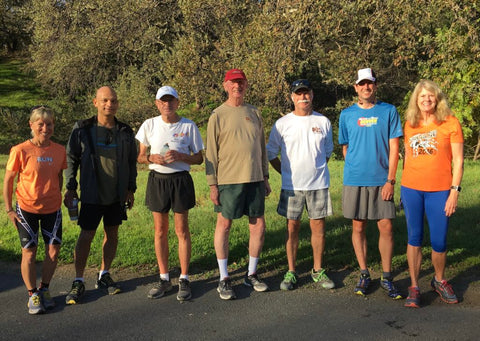Top Ten Tips for Trail Running Success

NEW TO TRAIL RUNNING? NO WORRIES!
KINeSYS Champion Nancy Hobbs, Executive Director of the American Trail Running Association gave us some helpful tips for those new to trail running.
TIP 1 - THINK TIME NOT DISTANCE
Throw out the preconceived notion of setting a PR (personal record), or running at a specific minute per mile pace when you set foot onto the trails. With varied terrain and changing elevation, what was once an eight minute per mile pace now becomes ten to twelve minutes per mile, or more. Instead of setting a distance goal, set a time goal for a trail run and worry not about how far you run in that time. Start out with a 30-minute run and enjoy the experience. Add time as you get more comfortable on the trails.
TIP 2 - BE PREPARED
Be prepared for the conditions what they are, and what they might become. Just because you look up at the sky and it is sunny and warm, doesn’t always mean it will remain that way throughout a run, especially if it is a long endeavor. What starts out in sunshine, may end up in rain, hail, or chilling wind and cold. Carry what you might need for the conditions you may encounter during a run. This may mean a wind jacket, hat, and gloves along with hydration and nutrition to sustain your adventurous spirit. Cold winter weather provides a unique challenges for trail runners requiring even more specific solutions.
TIP 3 - CARRY A MAP
Learn about the trail where you plan to run. You may want to do research beforehand to check out the terrain, elevation profile, parking details, type of markings along the trail, and potential hazards. Take a photo of the course map to orient yourself at the trailhead and at various points along the trail, especially if you are in an unfamiliar area. Since you may lose battery power along the way, a map folded and placed in a plastic baggie is an ideal backup plan.

TIP 4 - WALKING IS OK
Just because it is called Trail Running, doesn’t require that you run every step. There are often times the terrain or elevation requires slowing down to hike, or walk. When doing an event, you can follow this simple formula: walk until it gets too easy, run until it gets too hard and then repeat steps one and two until the finish line is reached.
TIP 5 - GET THE RIGHT FOOTWEAR
Because we don’t all live right next to a trailhead, a transition shoe is often the best option unless you can invest in multiple pairs of running shoes to cover every terrain and situation in which you will find yourself. There are lighter weight shoes for predominantly uphill trail running, there are grippy tread patterns to help navigate slippery rocks and roots, there are stiffer options, and shoes with enhanced stability. Without the luxury to have a quiver of options, choose a shoe that transitions well from road to trail. When you find yourself spending more time on the trails, purchase a shoe that satisfies the terrain you plan to include in your daily outings.
TIP 6 - STOP AND ENJOY THE VIEWS
The minute you take your eyes off the trail underfoot is often the time you take a tumble. Stay alert, pay attention, and plan your foot placement. This will become second nature the more time you spend on the trail. Rocks and roots that were once impediments soon become navigable and fun obstacles. Since you are out in nature to find peace, quite, and serenity, stop to take in the views and maybe carry your phone along to snap some pictures to share with friends and loved ones.

TIP 7 - SHARE YOUR ITINERARY WITH SOMEONE
When going on longer adventures, and even some smaller adventures in unfamiliar or challenging terrain, let someone know where you are going and what time you plan to return. There are many stories that end badly when searches are not conducted as quickly as they could be. A simple notification to a friend or loved one, or leaving a note in your car at the trailhead as to your plans could be advantageous to a rescue party should you not return at the specified time.
TIP 8 - GROUP RUN ETIQUETTE
When running with a group, discuss the plan for the outing as a group. Note whether the faster people wait at intersections, or points along a route for the slower runners, or if everyone runs their own pace and meets again at a specified time. Another option is to have a lead runner and a sweep so that no one gets lost.

TIP 9 - KNOW THE AREA WHERE YOU ARE RUNNING
Piggybacking on tip three is to know and respect posted animal alerts and wildlife habitats and to refrain from crossing onto private property. If the area is flood prone, or gets very muddy from stormy weather, use another trail to avoid creating undo erosion or unnecessary hazards.
TIP 10 - TO RUN WELL DOWNHILL, TRAIN FOR DOWNHILLS
Runners often have a fear of falling and tiptoe down hillsides. While there is no shame in slowing your pace, if you want to get more adept at downhill technique, you have to train for it by practicing. Conversely, the same applies for uphill trail running. Practice, practice, and practice some more. You can do hill repeats for both uphill and downhill running.
 Skip to content
Skip to content







